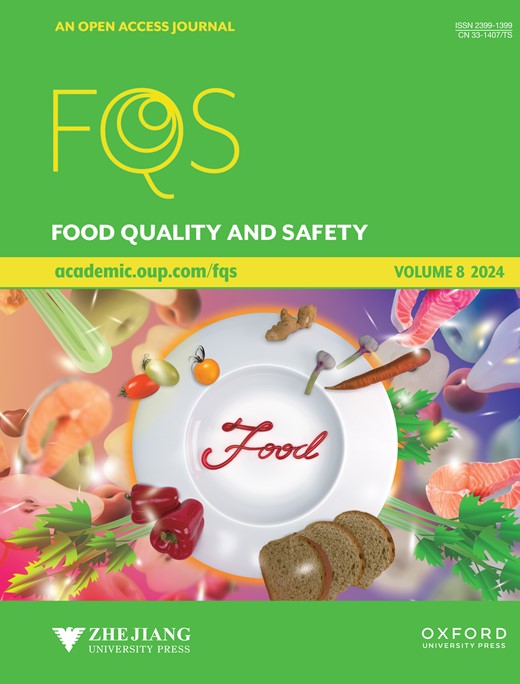作为生物活性物质的柚皮苷、新橙皮苷及其相应的二氢查尔酮:一首苦甜的交响曲
IF 4.4
3区 农林科学
Q2 FOOD SCIENCE & TECHNOLOGY
引用次数: 0
摘要
虽然苦味是风味的重要组成部分,但它通常是不受欢迎的。苦味物质具有多种促进健康的作用,这符合中国的名言“良药苦口”。柚皮苷(Naringin, NAG)和新橙皮苷(nehesperidin, NHP)是柑橘类水果中产生苦味的两种重要黄酮,具有不同的药理活性。有趣的是,它们的加氢产物,即柚皮苷二氢查尔酮(NDC)和新橙皮苷二氢查尔酮(NHDC),经历了从苦味到强烈甜味的巨大转变,其甜度分别是蔗糖的300倍和1000倍。这类甜味剂不仅提供甜味,而且不会增加热量摄入和血糖,还可能发挥多种生物活性。本文综述了膳食中常见的苦味和甜味化合物的感官评分。特别讨论了从苦味NAG和NHP到甜味NDC和NHDC的结构变化所引起的味觉转换。此外,还概述了这些苦甜可互换化合物的味觉感知机制、药理特性、膳食分布、合成和食品工业应用。总之,苦味NAG和NHP是治疗多种病因复杂疾病的有希望的治疗候选物,而它们对应的二氢查尔酮NDC和NHDC是有希望的甜味剂,这可能是那些需要控制糖摄入量的人的福音。本文章由计算机程序翻译,如有差异,请以英文原文为准。
Naringin, neohesperidin and their corresponding dihydrochalcones as bioactive substances: a symphony of bitter-sweet
Abstract Bitter is generally undesirable, although it is an important part of flavor. Bitter substances exhibit diverse health-promoting activities, which is in line with the famous Chinese saying ‘a good medicine tastes bitter’. Naringin (NAG) and neohesperidin (NHP), two important flavanones that give bitterness to citrus fruits, show various pharmacological activities. Interestingly, their hydrogenation products, i.e. naringin dihydrochalcone (NDC) and neohesperidin dihydrochalcone (NHDC), undergo a dramatic taste shift from bitter to intensely sweet, which can be 300 and 1000 times sweeter than sucrose, respectively. Such sweeteners not only provide a sweet taste without the burden of increased calorie intake and glycemia, but also may exert multiple bioactivities. This review summarizes common dietary bitter and sweet compounds with sensory scores. Taste conversions induced by structural changes from bitter NAG and NHP to sweet NDC and NHDC are particularly discussed. In addition, the taste-sensing mechanisms, pharmacological characteristics, dietary distribution, synthesis, and food industry applications of these bitter–sweet interchangeable compounds are outlined. In conclusion, the bitter NAG and NHP are promising therapeutic candidates for management of diverse etiologically complex diseases while their corresponding dihydrochalcones NDC and NHDC are promising sweeteners, which might be a blessing for those who need to control sugar intake.
求助全文
通过发布文献求助,成功后即可免费获取论文全文。
去求助
来源期刊

Food Quality and Safety
FOOD SCIENCE & TECHNOLOGY-
CiteScore
7.20
自引率
1.80%
发文量
31
审稿时长
5 weeks
期刊介绍:
Food quality and safety are the main targets of investigation in food production. Therefore, reliable paths to detect, identify, quantify, characterize and monitor quality and safety issues occurring in food are of great interest.
Food Quality and Safety is an open access, international, peer-reviewed journal providing a platform to highlight emerging and innovative science and technology in the agro-food field, publishing up-to-date research in the areas of food quality and safety, food nutrition and human health. It promotes food and health equity which will consequently promote public health and combat diseases.
The journal is an effective channel of communication between food scientists, nutritionists, public health professionals, food producers, food marketers, policy makers, governmental and non-governmental agencies, and others concerned with the food safety, nutrition and public health dimensions.
The journal accepts original research articles, review papers, technical reports, case studies, conference reports, and book reviews articles.
 求助内容:
求助内容: 应助结果提醒方式:
应助结果提醒方式:


